3 Strategies from a Bot Design Expert: Obaid Ahmed, Founder of Botmock
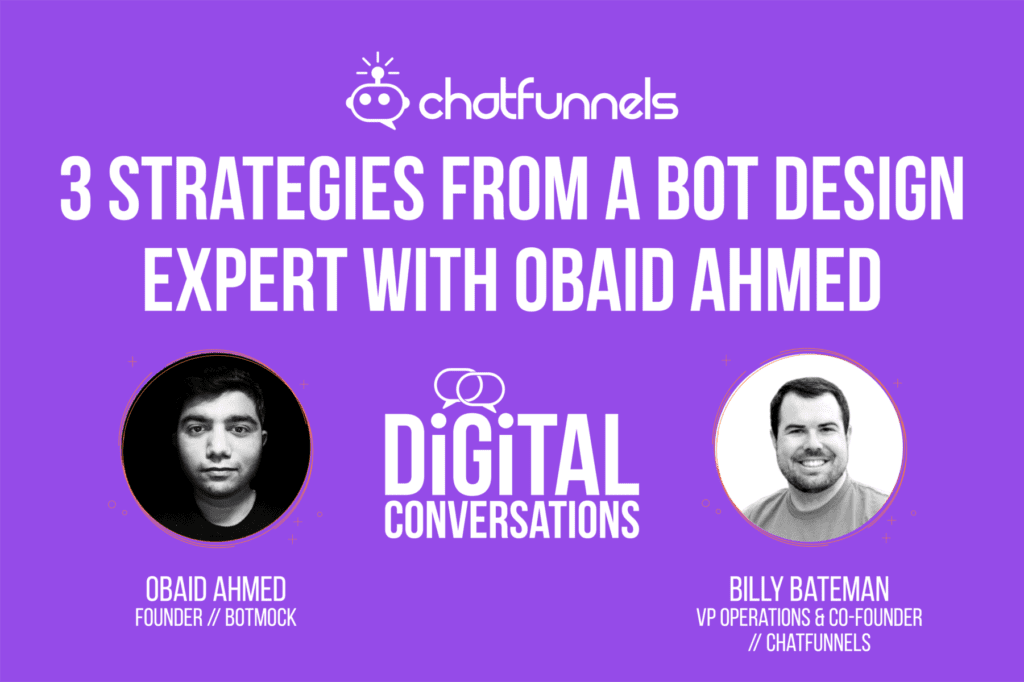
Reading Time: 13 minutes
Podcast: Digital Conversations with Billy Bateman
Guest: Obaid Ahmed– I am an entrepreneur, mentor and technologist at heart. An expert in building technology, UX/product design, large scale software design and business models. I’ve worn many hats in my career such as programmer, architect, strategist, marketer and writer. I have a unique ability to handle multi-disciplinary projects and to navigate complex challenges.
I have also been involved in the community as a mentor for early stage startups. Providing advice and insights on their business models and get-to-market plans. I am also involved in bringing crowd funding to local communities. I created UmmahHub as a project to bring crowd-funding to Muslim communities around the world.
I have been honored to receive the Youth Business Entrepreneur in 2012 and I am also involved in YoungMaker project which introduces the concept of technology to young members of our community via a 3D printer. Currently working on building the future of conversational apps using Voice, text and AI.
Overview: In this digital conversation Billy Bateman, our host and guest, Obaid Ahmed founder of Botmock discuss 3 strategies to designing a bot or voice recognition device: collaborating with others to represent your companies voice, testing bots early on and starting simple and then expanding.
Reference:
data:image/gif;base64,R0lGODlhAQABAAAAACH5BAEKAAEALAAAAAABAAEAAAICTAEAOw==
Billy: All right, everybody, welcome to the show. Glad to have you with us today. I’ve got Obaid Ahmed, the founder of Botmock as my guest. Obaid, thanks for joining us.
Obaid: Thank you for having me. I’m excited.
Billy: Yeah, really excited to talk to you. So you’re going to tell us a little bit about Botmock and how people can use it and tools like it to help them use bots effectively. But before we jump into that, I’d like you just to tell us a little bit about Botmock and how you got started?

Obaid: Botmock is a chatbot conversational system design prototyping tool. Whether you’re building a voice experience or a text based chat bot or anything in between both side of things, you can use Botmock to envision your bigger picture and figure out what is a get to build, test it out and then go from there. It gives you confidence in terms of what you’re going to build. And the way we actually built it is was that we actually backed into it to ourselves. We were running a consulting firm in 2016 working with a lot of existing businesses. And this was when Facebook Messenger just had a really big push on chat bots. So, a few of our customers asked how they could leverage this? And we thought about creating some sort of prototype for them to try out a few things. And we found that there was really no good way for us to do that. And out of the frustration, we started building this tool for ourselves. And then they showed it to a few of the marketing agencies and the people that were building chatbots around us. And we were told that everybody was looking for something like that. I just felt this all out. We went from just doing it for Facebook Messenger to now doing it for eleven different platforms.
Billy: That’s a great way to start a company, already knowing you have some customers in need. And then before we get into the meat of this, we’d love to just get to know you a little more as a person. So, outside of work what’s one or two things you’re just really passionate about?
Obaid: I am really passionate about sports. I love my cricket and I love my soccer. I can spend pretty much all day with cricket. You can spend the whole day of the game, it takes about eight hours to play and to watch anything like that. It’s actually a really good balance if you want to sort of work on your laptop and just watch a game as it is. It’s was perfect. I love following it. It’s a great sport. And soccer by itself is really easy, crazy to follow. It’s global. It works. And I get to choose my team. Recently, I decided to change my teams up. I’m not one of those hardcore Liverpool or Chelsea fan. I’m like this year I’m going to switch it up and support some other team and see how that feels. It keeps it exciting.
Billy: Interesting, I had no idea a cricket game could take eight hours. I’ve never watched it. I’ll have to find a whole day to dedicate to it sometime. So, okay, well let’s dive into this. At Botmock you guys you guys help people really get in and design conversations. I wanted to ask you, how should people think about conversational interfaces?
Obaid: That’s a good question. So, I think we went through a couple of iterations of what chatbots can do for the industry and what these voice systems can do, and I think we are still trying to figure out this new type of interface. But the best way I think people need is to start think about is that what use case can you solve for your business; what can be done for your customers or for your business on this conversational interface. Not every use case can be applied on Alexa. Not everything for your business needs to be on chatbots and it’s not supposed to be just limited to customer service.
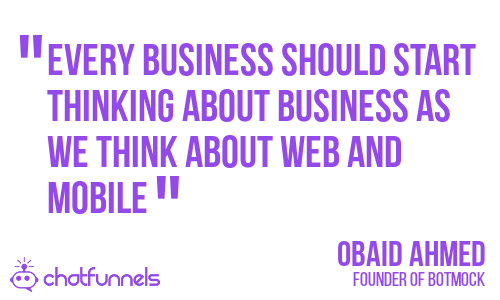
Every business should start thinking about business as we think about web and mobile. When mobile phones came out in 2007, we had to think, what does that screen size mean to us and what does a mobile app really mean for your business? Now it took us a while to go from shrinking down your big web sites and your FAQs to your mobile app to now offering transactions on it.
I think that’s what’s happening with conversational interfaces too, and we’re going to find our space around it. So, if you’re thinking about a chatbot, you’re thinking about how is this going to help, you need to start planning out those use cases, bring them up, test them out, see whether it feels right. What are your customers willing to do on these devices and how do you meet them at that medium?
Billy: With your customers that are that are using Botmock, what are you seeing as your most successful use cases right now?
Obaid: We see a lot of people starting from voice and then a lot of them switching or starting from the other side of it, which is their own custom websites; chatbots on the Web site. Sales seems to be the easiest use case. Customer support and sales it seems. So, these one, I think it’s also because they kind of have very specific use cases. The scripts are kind of easier to find. If you have a call centre running, you already have the data set. You can easily back yourselves out when doing, say, one of the most common tier one or two conversations. How do we automate them? The challenge, though, is for them to look beyond that and then think about it from not just from automation perspective, but from transactional perspective on what are other things that people can do.
There have been some customers of ours. We’ve sort of taken that approach and they are really pushing the boundaries of it and say, OK, maybe it’s not just transactional or just a FAQs or it’s agent handle where you try to do as much as of the IBI experience on Alexa or on your chatbot and menu driven, you do a little bit more and maybe build a relationship with your customers and get them to warm up to your brand more over time and provide some of that value out of it.
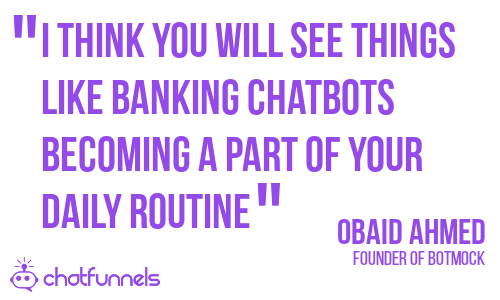
I think you will see things like banking chatbots becoming a part of your daily routine. So, them talking to and saying, hey, we have set the budget this month. Let me help you save for that vacation by telling you that, hey, I noticed that the day you eat out for the fifth time in a day and the week may be coming back a little bit. You’re not gonna get the vacation done. This data is already there, but they have to rethink that relationship because they wouldn’t call you up about this information and say, hey, I’m Billy, I notice that you’re eating out a lot, that I stop looking at things like conversational interfaces can have that relationship.
Billy: That’s interesting. That’s something we’ve seen as well as with our customers. We start off with very transactional use cases. Where’s the problem, whether it’s sales or customer support, let’s use the bot to solve it. But then eventually using it for more things. You just for writing a great experience for them, you know, on the Web site, helping them find what they need and figuring out who these people are. That’s interesting. The bank use case, I think you might have been looking at my credit card statement with how many times i’ve been eating out.
Obaid: It’s true for me too. Thats the use case I always look at my receipts and I’m like, yeah, like.
Billy: It happens. So, to dig in a little bit deeper then? What’s the difference between a conversational interface and another existing medium such as the web? There’s the traditional Web sites that we’re using.
Obaid: Yeah, I think so. Even in conversation interfaces. You have to think about voice, and you think about these text based chats and how does your brand and balance between the two. Voice has a lot of benefits in terms of being accessible. People don’t need to really know how to use too much of it if the interface is frictionless, but at the same time it’s quite public. Maybe it doesn’t fit extremely well for your use cases all the time. But the way I actually think about the Web and the application to mobile, and those kind of strategies where we saw that in the early days of mobile phone, everybody was trying to figure out a way, do we use it; how do we use this thing to provide value to our customers? And, you know, we went through this phase of [far too] apps, I’d like to call it, you know, like every app was like a one, but an app and all that stuff. And then somebody found those clinging on with. They figured out, okay, it’s not about re-sizing your Web site. It’s not about just reconfiguring your website to be mobile friendly. It’s about the transaction that value that you’re gonna generate. And everybody was like, mobile is here, web is here. Desktops are going to die away, the desktops not going away. These mediums will coexist.
Your conversational mediums are going to coexist with it. There are times when I actually want to use your mobile app to interact with your brand. And then there are times when I just want to chat with somebody or an automated or a human agent to get my value out of it. If I’m searching for flights, depends on my context. I might be exploring my options and I don’t want to chat with something or go to an agent. I want to chat with an automated system that works very, extremely well for me.
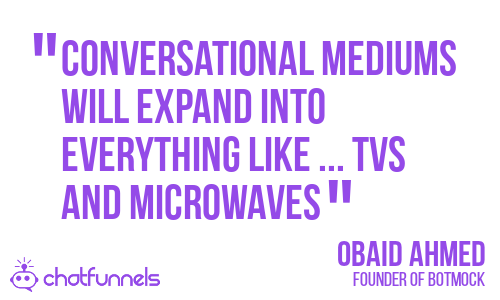
You need to sort of think about how does this paradigm work for your brand and then really scale down and understand what this medium can offer you for your brand and for your customers. And we’re going to see this conversational medium expand into everything like we’re already seeing it really from airports to your TV’s, your microwave, everything can be talked to. How do we do that? Right. If you are a, if you’ve watching something on TV and you like it, you like that product that you like. I want to do something, but I want to buy that that particular product and watch my show and all. I want to find out something more about that show or I want to tell my, I’m going to watch my Netflix show and I want to say something like, hey, Netflix, queue the next five one my phone automatically download them on my app because I’m going to be traveling so on to watch it later on. Netflix perspective that’s a conversation now.
I don’t need to draw it on my menus and then say, OK, I want to save this. But on that device, I think that’s what something that Amazon was already doing with Kindle devices. And you can buy something online and send it to my Kindle. That’s going to become more conversational because why not? I’m in the moment. I want that. And vice versa can happen to your car, to your Alexa device at home devices are going to be interesting. You start a conversation in your kitchen with Google device that you walk into a car, you plug in your phone or you connect your phone and you’re like, let’s go there. And the device should know what there means. Not like the context hasn’t changed. I’m still talking to Google here. So, your brand will happen the same way. People can start talking to a different medium. So, you need to figure out how would that interface? How would you exist with the interface? Well, what is the nuance of that interface as well? I think we went through this phase, as you know, from Web to mobile and all those devices.
There’s a lot of learnings we have, but there’s a lot of re-learnings like we have to reapply those learnings of this new interface and say, OK, what does this mean? How do we do this stuff? And it’s almost like I don’t want to call it responsive interfaces again, but it’s similar to that. Right? I mean, we learn we figured now we have to do the same thing again and do it rapidly because this medium is growing really, really fast compared to everything else.
Billy: Where do you guys see most of the growth coming? Is it in chatbots or more towards voice?
Obaid: I think there’s more maturity towards chatbots. There’s a lot more projects happening on chatbots right now, but there’s a lot more curiosity on the voice side of it. It has a lot of appeal. A lot of businesses are finding it hard to understand right now, a little bit, I would say. But they’re willing to experiment on it. They’re willing to figure out how do we really leverage it. And the good thing that’s happening with voice that I think will happen next few years really rapidly is that while it was started with Alexa and Google assistant, I think voice is going to become one of those mediums that brands can bring in-house to their own devices, their own services there, too. Your Samsung, like, for example, with Bigsby now it’s accessible, but their phones are accessible, the TVs are accessible, fridge and everything else is going to be like your remote controls. It doesn’t have to be just your Kindle Fire or just your Apple ITV like Apple TV remote to be voice controlled. Why not your Samsung TV or any reason we’re so remote can be voice activated?
Billy: One more question before I let you go is. How do you design, one thing the we know about is testing our bots. And I want to ask you at Botmock, how do you design testing for conversational enterprise experiences?
Obaid: That’s a good question. One thing that we have been advocating is do design testing as early in your process. And what we find a lot of customers struggle with is the tooling around it. How do you get a quick prototype out in front of your user focus groups, your stakeholders, your users and test it out? And before you commit to that design, before you go too deep into that direction, figured out that none of this really works for us. You could go back to the scratch and the way we think, and this is going to be a little bit of shameless plug, but that’s one of the focus of Botmock that we have had in 2019. It’s the now that you’ve designed these prototypes, test them out. How do you test them? How do you get the data and actually make it actionable? A lot of testing like now is happening on the production side of it.
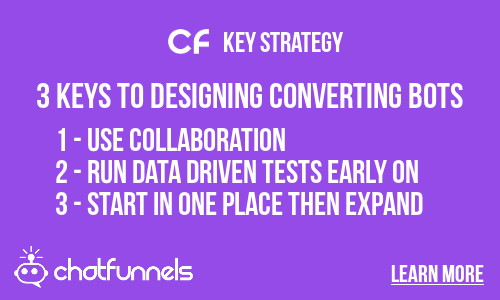
You do a lot of these expensive POCs and then you push it all out and then you learn and then you go back and you’re like, oh, none of this actually works. So, let’s throw this POC completely and do it again. And then that kind of leaves a very bad taste in the management team. And then suddenly in the team itself, the chatbots don’t work. This is not for us. What it might just be that you tested the wrong thing. You deployed the wrong POC and you invested so much energy into it that you’re burnt out either financially or just from a data perspective. You’re like, this is just not worth it. But I think the earlier you can test these things out, you can actually test a lot of use cases quickly and then say these are the ones that we are getting really good response on. So, let’s build those out a little bit more and then you can actually build a little more detail POC. But with high confidence, that this is not going to completely fail, this is some learning you can have from there and you will continue to improve it, but at least you have more confidence in what you’re doing.
Billy: You make a great point with, you know, you build a bit a bot you deploy it and, you know, especially the first time you’re going after any any new use case with it. There’s a high chance it’s going to fail or not work to the level that you’d be happy with and being able to iterate very quickly on those on those bots and see what’s working and what’s not. And deploy those changes is key to making everybody happy and having success. Okay. And then I always ask everybody the last question is, you know, if somebody is getting started using bots and chat bots, what is your one piece of advice to them?
Obaid: The best advice would be to think about the use case first and really focus on those use case from a data driven. You can actually use a lot of data driven sort of investigation to figure it out those use cases. Pick a few that really mattered for your business and then apply them, work them out first and then worry about the outside scope of those use cases. I think if your bot tries to do too much, too early, you can fail. If it tries to do too little, you know, and then there’s no attractiveness to it. You have to find the right balance. And but thinking about it and then doing those exercises early on, it definitely helps.
Billy: Couldn’t agree more. We tried to do the same thing with our customers that pick one or two use cases that have enough need that you can get some value, but don’t try to do everything all at once. Okay, Thank you Obaid. Now, where can people connect with you and learn more about BotMock.
Obaid: Absolutely, so the best way to learn about Botmock is Just go to Botmock.com and to find us on twitter @Botmock. I’m @obaid. That’s where you find me.
Billy: Ok. Thank you. And with that, we’ll call it a wrap for today. Remember to rate and review the podcast. And if you have any suggestions, you can find me on LinkedIn @BillyBateman and send me the messages. Thanks, guys.
Host: Billy Bateman – Billy Bateman is the co-founder and VP of Operations for ChatFunnels, the digital conversation analytics, and optimization solutions provider. He has a background in digital marketing, operations, and entrepreneurship. Billy grew up in Idaho and graduated from Brigham Young University and has a Masters of Business Administration from Boise State University. While at BSU, he completed Boise State’s Venture College Entrepreneurship Program and became a mentor and entrepreneurial lead on a technology commercialization project. He is an avid outdoorsman and enjoys fishing and hunting. He currently lives in Springville, Utah, with his wife, Chelsea.
